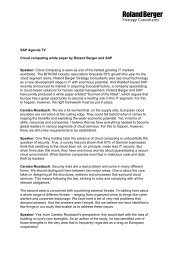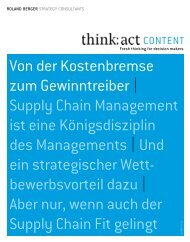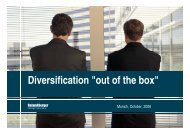Customer-centric retailing â Now you know what ... - Roland Berger
Customer-centric retailing â Now you know what ... - Roland Berger
Customer-centric retailing â Now you know what ... - Roland Berger
You also want an ePaper? Increase the reach of your titles
YUMPU automatically turns print PDFs into web optimized ePapers that Google loves.
<strong>Customer</strong>-<strong>centric</strong> <strong>retailing</strong>relevant competitors. More detailed analysis revealedthat both the available product selection and the pricepositioning were suboptimal. This gap was quickly closedon the basis of the CCR approach, and the customersresponded positively.Such an approach can be used to deduce differentiatedstrategies for each customer group, the essential aimbeing to give the customers more added value by offeringmore attractive ranges and services and an improvedpricing policy.4. Align <strong>you</strong>r product category strategyOnce <strong>you</strong>'ve defined <strong>you</strong>r target-customer segments andstore clusters, the next step is to define <strong>you</strong>r strategicguidelines, category role, target-customer segments, etc.,for each category. It's best to start with a detailed analysisof the market position and the importance of the productcategory in the overall range. The next step is to determinethe product category's performance – compared to themarket and leading competitors, as well as from the pointof view of consumers. Based on the optimization potential<strong>you</strong> identify, <strong>you</strong> can then decide which customer segmentsto target in future and which ranges/products,prices and promotions to consider.5. Optimize <strong>you</strong>r rangeYour next aim is to provide a range of products that is asattractive as possible for the defined target-customersegments. To do this, <strong>you</strong> must find out which customersprefer which items, how loyal they are to these products,and how many buyers are reached by the individual products.The "RB Category Optimizer" is used to create adecision tree showing purchase decisions for each customersegment and product category. It reveals the logicfollowed by the customers when they are in the store –right down to their purchasing patterns at the shelves.This allows conclusions to be drawn for a more customerfriendlyproduct chronology and better merchandising.Optimizing <strong>you</strong>r range from the customer's perspective:Here is an example from the field of detergents. The laundrydetergent products (page 10, photo on the left) arearranged according to the traditional industry-dominatedshelf system – by brand and package size. As a result,the arrangement is not governed by how customers tendto buy. Products that customers feel belong together arearranged separately; the shelves offer little in the wayof orientation.The photograph on the right shows how customers wouldset out a shelf of laundry detergent products. The newla<strong>you</strong>t reflects how people actually buy: this is why, inthis case, products that customers think of as belongingtogether are placed next to each other on the shelves.Here we have copied the customer's first purchasedecision and separated liquid detergents from powderdetergents. We have also created vertical brand blocksto improve orientation.Today, decisions on inclusion and exclusion are stillvery much based on lists of fast and slow sellers andthe subsidies for advertising provided by manufacturers.However, such data does not give any indication of howimportant certain products are to individual customergroups. For example, although a high-quality skin creammight not be purchased very often, it could neverthelessbe an important product for the "conservative and brandconscious"customer segment. If <strong>you</strong> want to boost theloyalty of this customer group in the field of personalhygiene, <strong>you</strong> need to understand exactly which productshave a positive impact on customer satisfaction, whichproducts can be dispensed with, and whether there areany product gaps on the shelves.6. Optimize <strong>you</strong>r pricing strategyHow can <strong>you</strong> optimize <strong>you</strong>r pricing strategy based on abetter understanding of <strong>you</strong>r customers? As a general rule,food retailers tend to match their competitors' prices fortheir best-selling products with the aim of improving theirprice image among the customers. This "watering can"approach is a waste of margins because it involvesinvesting indiscriminately in the prices.9
















